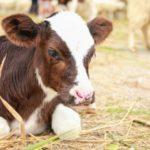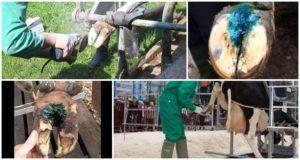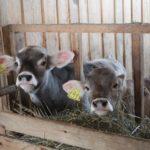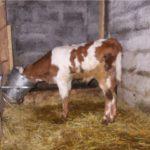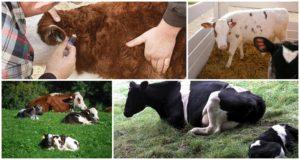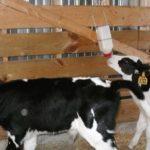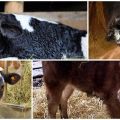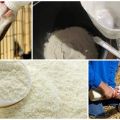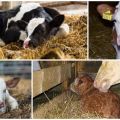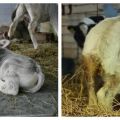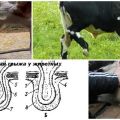Causes of diarrhea in a calf and how to treat it quickly and effectively at home
Infectious or non-infectious diarrhea in calves is a common problem that needs to be addressed immediately. Due to diarrhea, the calf becomes dehydrated, the body is depleted, the mucous membranes of the digestive tract become inflamed, which, if untreated, leads to death. It is necessary to start treatment immediately after the diagnosis is made by a veterinarian; animals can be treated with medicines and folk remedies.
What is diarrhea?
Diarrhea is a violation of defecation, accompanied by an increase in the output and liquefaction of feces, an increase in body temperature, intoxication, and a decrease in appetite. Normal feces in a breastfeeding calf:
- mushy;
- homogeneous;
- yellow or brownish;
- intensely smelling.
A healthy dairy calf defecates after each suckling and a couple of times between feedings. Young animals that have switched to adult feed should have normal feces:
- brown or brownish green;
- dense;
- intensely scented silage.
Healthy young growth is emptied 6-10 times a day. More frequent emptying signals pathology. Diarrhea in calves takes 3 forms:
- light - liquefied feces, but not watery, the animal does not lose appetite;
- medium - liquid feces, comes out often, the calf loses appetite, but the dehydration is not strong;
- heavy - the feces are watery, the animal is lethargic, it rises with difficulty, staggers, the body is dehydrated.
Causes of diarrhea in calves
The causes of diarrhea in calves are infectious and non-infectious.
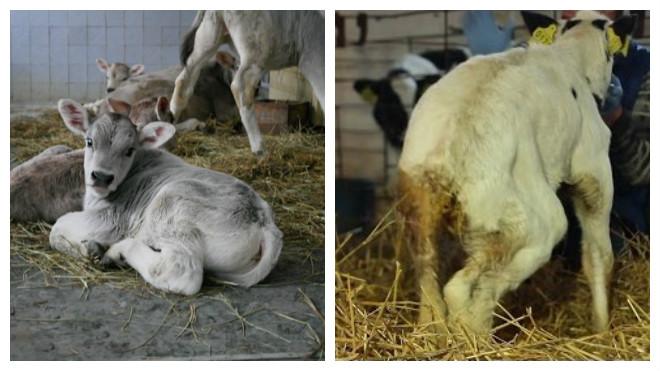
Non-infectious provocateurs of pathology:
- poor quality combined feed;
- non-observance of hygiene rules;
- helminthiasis;
- poisoning with poor quality feed;
- a sharp change in diet;
- overeating;
- weakening of the immune system;
- hypovitaminosis;
- stress.
It is enough to work in the barn with dirty tools, put the feed in an unwashed feeder for the calf to feed. Less often, diarrhea in young animals occurs after vaccination against the background of weakened immunity.
Infectious causes of diarrhea in calves:
- Anaerobic enterotoxemia is a bacterial infection that causes severe intoxication that affects the nervous system. It is transmitted by contact and through feed.
- Salmonellosis is a bacterial pathology that occurs when there is unsanitary conditions and crowded keeping of animals. The pathogen is transmitted through the digestive tract.
- Colibacillosis affects newborn infants with weakened immunity. Infection is provoked by unsanitary conditions, chronic pathologies in the mother cow, hypovitaminosis, and liver failure.
- Rhinotracheitis is a viral pathology of cattle, leading to mass mortality of young animals. The herpes virus is transmitted by contact, through food, less often by airborne and placental methods.
- Adenovirus mainly affects young animals up to one month of age. The virus moves by airborne droplets, through food and dirty bedding, captures the respiratory, digestive, lymphatic systems, and organs of vision.
- Rotavirus is transmitted by sick animals. Intrauterine infection of the fetus is possible.
Associated symptoms
Symptoms accompanying diarrhea depend on the cause of the pathological condition. Common symptoms of diarrhea of any origin:
- fast weight loss, exhaustion;
- lethargic, drowsy, apathetic state;
- weak or absent appetite;
- drying out of the nasal passages and upper lip area;
- dry skin;
- blanching of the mucous membranes;
- fever, fever.
The calf, which often chicks, develops poorly, lags behind peers in height and weight. The body does not receive enough nutrients, vitamins, minerals contained in the feed, since they are excreted with liquefied feces. Loose stools lead to dehydration, metabolic disturbances, and intoxication. Bloody diarrhea signals an inflammatory process in the digestive tract. If thin blood streaks or lumps are visible in the feces, then a foreign body has entered the intestine, traumatizing the mucous walls.
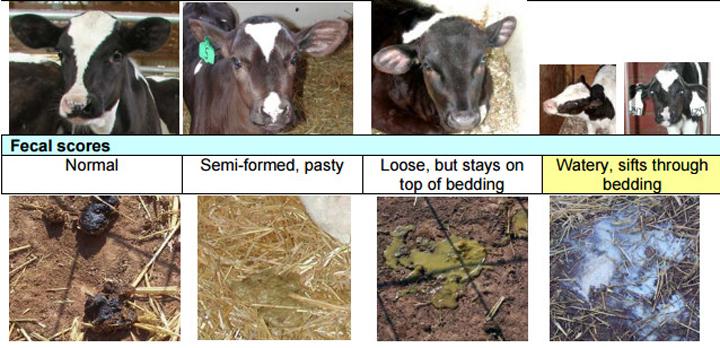
White diarrhea is a sign of helminthiasis or hypovitaminosis. If a newborn calf defecates with yellow liquid feces, then the problem is poor quality feed or a disturbed feeding regime. The color and structure of feces are not the same in infectious pathologies:
- Anaerobic enterotoxemia - dark brown diarrhea, bubbling, with bloody impurities. The animal has a fever, impaired coordination of movements, muscle spasms, rapid breathing.
- Salmonellosis - a liquid mass spontaneously flows from the anus.
- Colibacillosis - yellow-gray, watery, foul-smelling diarrhea, flocculent, mucous, bloody inclusions are noticeable in it. Colic is noted, the abdomen is hard and painful, the eyeballs are sunken.
- Rhinotracheitis is accompanied, in addition to diarrhea, high fever, rapid breathing, coughing, the release of frothy saliva from the mouth and clear mucus from the nose. Gradually, the nasal mucus becomes purulent, pneumonia occurs, the body of the animal becomes covered with ulcers.
- Adenovirus - brown-gray diarrhea with mucous membranes, less often blood inclusions. A one-month-old calf has profuse nasal and eye discharge, dry cough, shortness of breath, heart palpitations, and excessive gas production. After 3-5 days, the nasal discharge becomes purulent.
- Rotavirus - feces watery, gray-yellow, smelling sour, later blood streaks appear. Despite dehydration, the calf refuses to drink. The heartbeat becomes more frequent, dense saliva flows out of the oral cavity.
Diagnosis of the disease
The diagnosis is made by a veterinarian, analyzing the conditions of livestock, the quality of feed, symptoms. Takes biomaterial for bacteriological analysis.
The veterinarian asks the farmer:
- whether the body temperature of the animal changes;
- what the calf ate;
- how long the diarrhea lasts;
- is there vomiting;
- how often the animal defecates.
During the diagnosis, the veterinarian takes into account the color and consistency of feces, the density and soreness of the calf's abdomen, dryness of the outer covers, and heart rate.
Home treatment
The sick animal is kept warm and dry, with good air circulation. The premises and equipment are regularly cleaned and disinfected. Overfeeding of a sick calf is prohibited. Milk, compound feed and salt are excluded from the diet until the digestive tract is restored. Treat the pet in accordance with the diagnosis.
Medication
Medicines are used for severe diarrhea caused by infection or intoxication. Medication can be given only after consulting a veterinarian, so as not to harm the animal's body.

Rehydrates
These are oral medications used to restore the water-salt balance in the body. The most popular remedy is called "Rehydrate". The medicine should be made as follows: dissolve 3 packs in 10 liters of water heated to 70 ° C, stir. Treatment lasts a week. In the first 2 days, the calf is drunk 6 times, the solution is added to 250 ml of cow's milk or substitute when feeding milk replacer. You can store the medicine for 3 days in a cool place.
Sorbents
These are body cleansers from toxins. The calf can be treated with Bifidumbacterin intended for humans, which quickly restores the intestinal microflora. The powder is dissolved in warm water - 1 serving per teaspoon of water. The daily rate is 12-15 servings, divided into 2 or 3 doses 30 minutes before feeding. The treatment lasts 1.5 weeks.
Enzymes
Should be given if diarrhea in the calf is associated with enzyme deficiency. An effective remedy is Gastrovet powder: 10 g is dissolved in 10 liters of water heated to 50 ° C. To stop diarrhea, add the solution to cow's milk, leave it for a while for fermentation, give the calf to drink. The daily dose, 90-110 ml, is divided into 3 doses.
Probiotics
These are restorers of intestinal microflora. Pharmacy "Bifidumbacterin", veterinary "Lactobifadol" and "Olin" are suitable. The dosage of "Lactobifadol" is 0.2 g per 1 kg of body weight, the drug is dissolved in water at 30 ° C, given 2 times a day with food, the treatment is continued for at least a week. Probiotics are diluted just before use, since the lifespan of beneficial bacteria in the external environment is short. For the treatment of dairy calves less than a month old, use "Monosporin". It is added to food for 50 g.
Antibiotics with electrolytes
Antibiotics are used for a bacterial infection that causes diarrhea. There is no cure for viral diseases; for prevention, calves are injected with vaccines. Of the antibiotics, "Tetracycline", "Levomycetin", "Biomycin" are effective. The dose is 15-20 mg per 1 kg of body weight. Electrolyte - Saline solutions that help with dehydration. They are easy to prepare at home, the basis of the composition is potassium, sodium, chlorine, glucose (but not sugar - the calf's body does not absorb it).
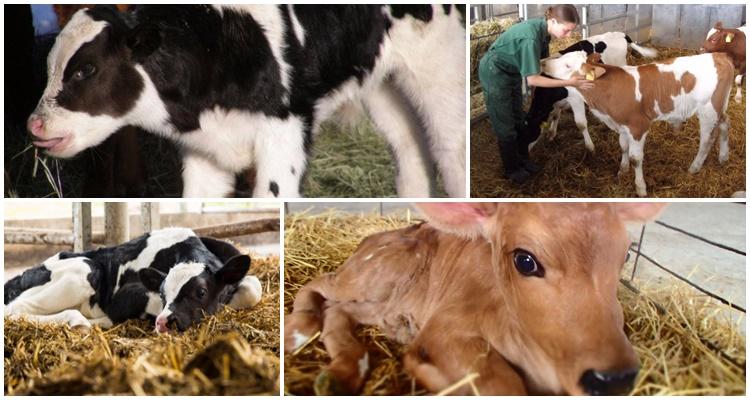
Folk remedies
Folk recipes are useless for infection; they treat mild diarrhea associated with improper feeding, moldy food. If the 2-3-day treatment was unsuccessful, then you need to immediately switch to medication.
Decoctions
To cure mild diarrhea in a calf, the following recipes are effective:
- 150 g of barley or rye grains pour 1 liter of water, cook for 30 minutes. Give the strained broth to the sick calf for 2 days. Divide the daily portion of 0.5 liters into 5 doses.
- 50 g of flaxseed pour 1 liter of water, cook for an hour. Add 2 liters of boiled water to the strained broth. Give 2 times a day for 0.5 liters.
Tinctures
The following recipes help with diarrhea:
- 100 g of rose hips pour 1 liter of boiling water. Insist 8 hours. Feed the calf 200 ml 3 times a day.
- Dissolve 9 g of salt in 1 liter of boiling water. Pour in 200 g of finely chopped onions (variety with red husks), shake well. Pour in 100 ml of sunflower oil. Insist 2 days. Give the medicine 5 times during the day, the dosage is 5 ml per 1 kg of body weight.
Tea solutions
Add a large spoonful of salt, 3 raw egg whites to the tea brew (black, unflavored). Dose - 10 ml of solution per 1 kg of body weight. The treatment lasts a month.
When using folk remedies for diarrhea, the calf cannot be fed with milk.
What is the risk of diarrhea
Lack of therapeutic measures in most cases leads to death due to many complications. Viral pathologies in calves are complicated by meningitis, encephalitis, blockage of the airways. Rhinotracheitis is accompanied by convulsive conditions that turn into paralysis. Colibacillosis affects the lung and joint tissues. Enterotoxemia is complicated by hemorrhages, intestinal inflammation with the formation of necrotic foci.
In surviving calves, the body remains weak, the appetite is poor, the animals do not grow to normal weight. Cows with diarrhea at a young age have low milk yield.
How to prevent diarrhea in calves
The main preventive measures are maintaining cleanliness in the barn, using high-quality feed, strengthening the immunity of calves by drinking colostrum. To prevent diseases that lead to diarrhea, farmers:
- comply with the sanitary recommendations for keeping cattle;
- regularly vaccinate livestock;
- use feed additives to prevent mold growth;
- give calves vitamin complexes and supplements to improve digestion, strengthen immunity;
- immunize pregnant cows one month before delivery;
- new animals are kept in quarantine.
Prevention of diarrhea in calves is easier than treatment, it is enough to create good conditions. If the diarrhea has already begun, then all methods approved by the veterinarian should be used to save the animals from death.


